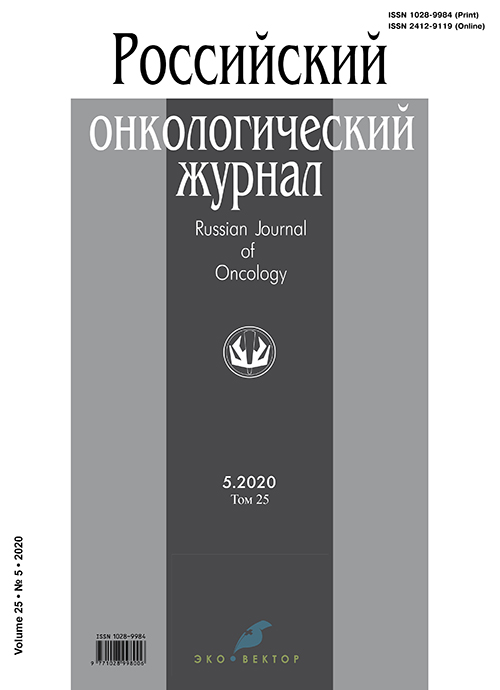Том 25, № 5 (2020)
- Год: 2020
- Выпуск опубликован: 15.10.2020
- Статей: 5
- URL: https://rjonco.com/1028-9984/issue/view/3827
Клинические исследования
Эпидемиологические особенности злокачественных новообразований шейки матки в Алтайском крае
Аннотация
Цель исследования: изучить эпидемиологические особенности злокачественных новообразований шейки матки в Алтайском крае.
Материал и методы. Использованы данные популяционного Cancer-регистра, сформированного в КГБУЗ «Алтайский краевой онкологический диспансер», город Барнаул. Cancer-регистр включает сведения о 253 тыс. пациентов со злокачественными новообразованиями, в том числе 12259 женщин, страдающих раком шейки матки. Изучены «грубые» (на 100 тыс. женского населения) и стандартизованные (мировой стандарт на 100 тыс. женского населения) показатели заболеваемости злокачественными новообразованиями шейки матки и смертности от них в Алтайском крае за 20 лет. Проведëн анализ заболеваемости и смертности раком шейки матки в динамике по годам и в отдельных возрастных группах.
Результаты: за период 1989–2018 гг. в Алтайском крае произошло значимое смещение заболеваемости злокачественными новообразованиями шейки матки в сторону увеличения в группах молодого репродуктивного возраста. За период 2008–2018 гг. отсутствует положительная динамика показателей ранней диагностики (доли ранних – I и II стадий (%) среди впервые выявленных пациенток раком шейки матки) и запущенности (соответственно доли III и IV стадии, %). Удельный вес умерших женщин в структуре онкогинекологических заболеваний в Алтайском крае превышает подобный уровень в Российской Федерации.
 164-169
164-169


Эпидемиология и клиническое течение меланомы вульвы (на примере Республики Башкортостан)
Аннотация
Распространëнность меланомы в Российской Федерации составляла 66,9 на 100 тыс. населения в 2019 г., тогда как данный показатель в 2009 г. – 44,5. Меланома вульвы – одна из редких локализаций злокачественных опухолей в онкологии. Течение заболевания и распространённость отличаются от меланомы кожи. Ввиду редкости данной локализации каких-либо больших исследований, посвящëнных этой теме, не опубликовано в РФ.
Целью нашей работы было изучение клинического течения и распространëнности меланомы вульвы в Республике Башкортостан.
Материалы и методы. Проведëн ретроспективный анализ клинического течения злокачественных опухолей наружных половых органов у 324 больных за 5-летний период. В 23 случаях был установлен диагноз «меланома вульвы», что составило 6,5% от общего числа пациенток со злокачественными новообразованиями женских наружных половых органов. Проведён анализ клинического течения, медицинских данных у 23 пациенток с диагнозом «меланома вульвы». Проведена оценка стадии заболевания, особенностей клинического течения, наличия BRAF и c-KIT мутаций. В Республике Башкортостан заболеваемость меланомой вульвы оценена по материалам работы Республиканского клинического онкологического диспансера.
Результаты. Трудности в определении объëма адекватного хирургического лечения, наличие прогностических факторов определяют прогноз заболевания. Большая часть пациенток на первым этапе получила оперативное лечение. Объëм хирургического лечения определялся в зависимости от локализации первичной опухоли и наличия метастазов в регионарные лимфоузлы.
Заключение. Меланома вульвы – достаточно редкая и агрессивная злокачественная опухоль. В Республике Башкортостан, как и в Российской Федерации, нет единого реестра по данной локализации. Ввиду анатомических особенностей данной зоны опухоль ведëт себя более агрессивно, характерно раннее лимфогенное метастазирование. Достаточно молодой возраст, агрессивное течение заболевания требуют особого внимания к этой группе пациенток.
 170-175
170-175


Клинические случаи
Опухолеподобные заболевания брюшины. Описание клинического случая лечения перитонеальной инклюзионной кисты
Аннотация
В статье представлено клиническое течение редкого поражения брюшины. Ранее оно классифицировалось как мультикистозная мезотелиома брюшины, а в настоящее время относится к опухолеподобному заболеванию. Уникальность состоит в том, что, несмотря на морфологические признаки доброкачественного образования, мы наблюдали агрессивное течение болезни, которое выражалось в раннем и многократном рецидивировании.
 176-180
176-180


Гигантская кондилома Бушке-Левенштейна
Аннотация
Гигантская кондилома Бушке-Левенштейна – это большое, экзофитное, медленнорастущее, доброкачественное, бородавчатое поражение аногенитальной области. Причиной данной патологии является инфицирование вирусом папилломы человека, преимущественно 6-го или 11-го типа. Патогенез гигантской остроконечной кондиломы изучен недостаточно, еë часто считают промежуточным звеном между острой кондиломой и плоскоклеточным раком. Частота встречаемости в общей популяции составляет около 0,1%, что говорит о редкости данной патологии. Гигантская кондилома Бушке-Левенштейна впервые описана авторами Buschke и Löwenstein в 1925 г. В настоящее время в литературе встречаются описания в основном единичных наблюдений пациентов с этой патологией. Основным методом лечения гигантской кондиломы Бушке-Левенштейна является хирургический, задача которого – широкое иссечение опухоли в пределах здоровых тканей. Мы приводим клиническое наблюдение 36-летней пациентки с гигантской кондиломой Бушке-Левенштейна, которой произведено хирургическое лечение – удаление опухоли промежности больших размеров. На момент операции размеры опухоли составляли 25 × 15 см. Хирургическое лечение пациентка перенесла без осложнений, заживление первичным натяжением. В течение полугода с момента операции рецидива заболевания не выявлено. Таким образом, хирургическое лечение подобных опухолей – единственный метод, позволяющий рассчитывать на излечение пациента.
 181-185
181-185


Хирургическое лечение первичного рака желудка с метастазом в левую долю печени
Аннотация
Одной из нерешённых проблем на данном этапе развития онкологии остаётся лечение рака желудка с метастазами в печень. Если при колоректальном раке с метастазами в печень хирургическое лечение является стандартом, то роль резекции печени в лечении пациентов с неколоректальными метастазами в печень остаётся неопределённой. Представлен результат лечения распространённого рака антрального отдела желудка T3N1M1, mts in hepar, которое включало в себя расширенную комбинированную субтотально-тотальную резекцию желудка по Бильрот II, лимфаденэктомию по R-2 (по М.С. Сигал) с резекцией левой доли печени (S2 S3) и 2 неполных курса химиотерапии, что дало излечение на срок более 31 года.
 186-188
186-188












